
|
Folk Dance Federation of California, South, Inc.
By Dick Oakes |
THIS IS HISTORICAL INFORMATION ONLY
CLICK AN IMAGE TO ENLARGE
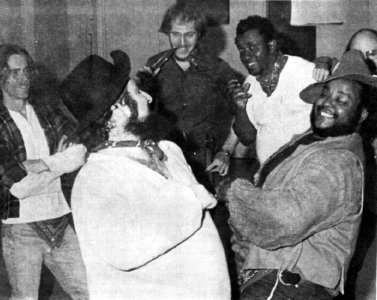
California Gold Miner Dance, The Liberty Assembly, 1983 |
The idea for a performing group such as The Liberty Assembly was founded on July 4, 1970, by Robin Evanchuk "just to see if it could be done" as well as to perform and defend traditional American music and dance. She had been choreographing American material for several dance troupes, including the Duquesne University Tamburitzans and Westwind (of which she was a director), and decided that there should be a troupe specializing in American folklore.
The United States of America was 194 years old and still growing and changing. That's what America is all about. People, expansion, clipper ships, cowboys, flappers, hymn singers, pitchmen, boogie, jazz, rock, and men on the moon.
At the time the interest in American folklore performance was, in a sense, just beginning and it seemed an appropriate time to form a company of individuals interested in bringing American traditions to the public.
The Liberty Assembly was a company of singers, dancers, and musicians ranging in age from 13 to 40 devoted to preserving the dances and songs of America, but, The Liberty Assembly was more than just a storehouse for unknown ballds and lonesome tunes. It was a performing group whose purpose was to educate and inform as well as to entertain.
The Liberty Assembly repertoire began at the Colonial period. Actually, the name "Liberty Assembly" was taken from the dancing Assembly of Philadelphia in 1776. These "Assemblies" were really subscription dances of the period. One Assembly was composed of members loyal to King George III. The other, "The Liberty Assembly," boasting names like George Washington and Benjamin Franklin on its membership roles who were the future creators of the Constitution.
The old Liberty Assembly lasted until before the death of George Washington when the members met for one last time for a "Birthnight Ball" to celebrate the birth of the country as well as Washington's birthday.
The new Liberty Assembly performed selections not only from the Colonial period but spanned American folk muisc and dance from the 1700s.
One of their more familiar selections was the "Shaker Worship Service." This was a reconstruction of highlights from a Shaker religious dance service of the mid-nineteenth century. Another selection devoted itself to California folklore and included songs and dances of the California goldminers and items from 1860 to 1880, the era of Phineas Banning, California Senator and founder of the Los Angeles harbor.
"Fad" dances were a third category of The Liberty Assembly repertoire and were the most requested on a program. They performed segments from the 1920s, 30s, 40s, 60s, and 80s. The favorites seemed to be the "Jitterbug," "Charleston," "Castlewalk," and "Cakewalk." Also popular was the "Big Apple."
Their "Charleston" came complete with original 1920s costumes, the collection of which began in the early 1970s when period clothing was being offered at many thrift stores for a very reasonable price.
The "Jitterbug" made its debut performance with The Liberty Assembly at Zorba's Folk Dance Coffeehouse in the San Fernando Valley. At that event two of their members, Kevin Quitt and Neil Siegal, presented the group with a real Wurlitzer Juke Box which became a permanent part of the stage decor.
The "Cakewalk," probably the most popular with audiences and performers alike, was actually a dance contest in which couples competed with one another to see which had the most skill in strutting and walking. The prize at first was a huge decorated cake. The expression "that takes the cake" in all likelihood came from this dance. Its popularity swept the nation and eventually Europe and the prizes changed from cakes to gold belts for the winning men and diamond rings for the winning women. If anyone had seen The Liberty Assembly's version of the "Cakewalk," you knew that they had remained with the tradition of giving away cake!
From its inception, The Liberty Assembly had performed many times before enthusiastic audiences. Those shows included performances before such critical organizations as the American Folklore Society, the California Folklore Society, and the Congress on Research in Dance.
In 1971, the group toured the State of Louisiana, presenting, among other things, a suite of songs and dances once done by the Acadian or "Cajun" people of that state. They continued to add to their repertoire with an Appalachian suite, Georgia ring-shouts, and the Texas Knockdkown.
In 1976, the group traveled to Wisconsin to their State Fair to celebrate the bi-centennial exhibition held in Milwaukee.
On March 14, 1985, the students performed the Shaker Service at a persentation for the scholarship benefit of the Westwood Women's Bruin Club. Aided by members of The Liberty Assembly, they received many enthusiastic comments and compliments and began work on two more events to be given in August and November.
On July 4, 1985, as the group celebrated their fifteenth year, the ensemble was in the process of beginning a whole new life with a fresh range of activities. The group donated its time to assist graduate students of the Folklore and Mythology Program at UCLA to develop performances of American material to be given at the University and the surrounding area.
The new phase of The Liberty Assembly activity allowed everyone to learn and all profited by their efforts. With new approaches and research and with dedicated, disciplined performers, The Liberty Assembly continued to be a phenomenon among folk ensembles.
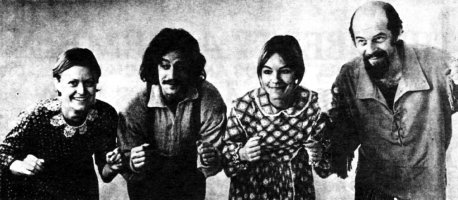
|
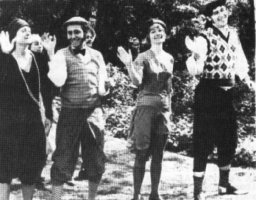
|
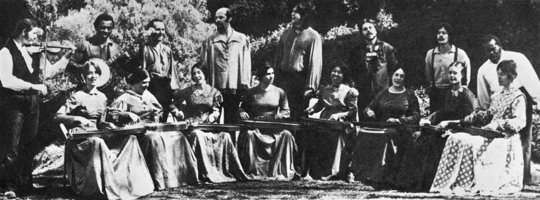
|

|
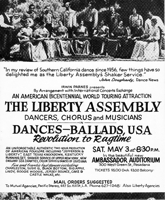
1975 |
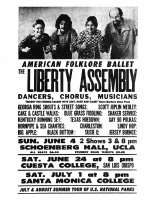
1978 |
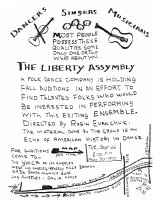
1978 |
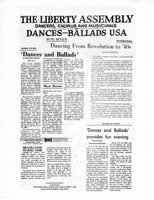
1978 |
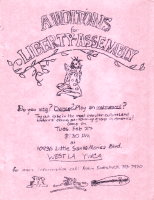
1979 |